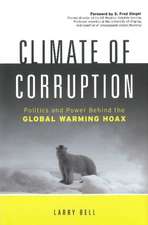Disturbance and Recovery in Arctic Lands: An Ecological Perspective: NATO Science Partnership Subseries: 2, cartea 25
Editat de R.M. Crawforden Limba Engleză Hardback – 31 mar 1997
| Toate formatele și edițiile | Preț | Express |
|---|---|---|
| Paperback (1) | 1832.22 lei 6-8 săpt. | |
| SPRINGER NETHERLANDS – 23 oct 2012 | 1832.22 lei 6-8 săpt. | |
| Hardback (1) | 1839.63 lei 6-8 săpt. | |
| SPRINGER NETHERLANDS – 31 mar 1997 | 1839.63 lei 6-8 săpt. |
Din seria NATO Science Partnership Subseries: 2
- 15%
 Preț: 638.43 lei
Preț: 638.43 lei - 5%
 Preț: 1420.29 lei
Preț: 1420.29 lei -
 Preț: 390.84 lei
Preț: 390.84 lei - 18%
 Preț: 949.90 lei
Preț: 949.90 lei -
 Preț: 401.24 lei
Preț: 401.24 lei - 15%
 Preț: 653.14 lei
Preț: 653.14 lei - 5%
 Preț: 1414.64 lei
Preț: 1414.64 lei - 15%
 Preț: 642.18 lei
Preț: 642.18 lei - 18%
 Preț: 1846.40 lei
Preț: 1846.40 lei - 18%
 Preț: 949.90 lei
Preț: 949.90 lei -
 Preț: 380.07 lei
Preț: 380.07 lei - 15%
 Preț: 643.84 lei
Preț: 643.84 lei -
 Preț: 416.64 lei
Preț: 416.64 lei - 18%
 Preț: 1234.77 lei
Preț: 1234.77 lei - 18%
 Preț: 1834.90 lei
Preț: 1834.90 lei - 18%
 Preț: 950.96 lei
Preț: 950.96 lei - 15%
 Preț: 655.78 lei
Preț: 655.78 lei -
 Preț: 403.53 lei
Preț: 403.53 lei -
 Preț: 381.98 lei
Preț: 381.98 lei - 18%
 Preț: 1836.94 lei
Preț: 1836.94 lei - 15%
 Preț: 645.47 lei
Preț: 645.47 lei - 18%
 Preț: 946.87 lei
Preț: 946.87 lei - 18%
 Preț: 1227.99 lei
Preț: 1227.99 lei - 18%
 Preț: 1232.57 lei
Preț: 1232.57 lei -
 Preț: 398.15 lei
Preț: 398.15 lei - 18%
 Preț: 1232.71 lei
Preț: 1232.71 lei - 18%
 Preț: 1223.88 lei
Preț: 1223.88 lei - 18%
 Preț: 1228.77 lei
Preț: 1228.77 lei
Preț: 1839.63 lei
Preț vechi: 2243.45 lei
-18% Nou
Puncte Express: 2759
Preț estimativ în valută:
352.05€ • 365.32$ • 294.26£
352.05€ • 365.32$ • 294.26£
Carte tipărită la comandă
Livrare economică 15-29 martie
Preluare comenzi: 021 569.72.76
Specificații
ISBN-13: 9780792344186
ISBN-10: 0792344189
Pagini: 621
Ilustrații: XVII, 621 p.
Dimensiuni: 155 x 235 x 44 mm
Greutate: 1.1 kg
Ediția:1997
Editura: SPRINGER NETHERLANDS
Colecția Springer
Seria NATO Science Partnership Subseries: 2
Locul publicării:Dordrecht, Netherlands
ISBN-10: 0792344189
Pagini: 621
Ilustrații: XVII, 621 p.
Dimensiuni: 155 x 235 x 44 mm
Greutate: 1.1 kg
Ediția:1997
Editura: SPRINGER NETHERLANDS
Colecția Springer
Seria NATO Science Partnership Subseries: 2
Locul publicării:Dordrecht, Netherlands
Public țintă
ResearchCuprins
I Arctic Communities, Past, Present and Future.- Arctic ecosystems and environmental change: perceptions from the past and predictions for the future.- Arctic phytogeography: plant diversity, floristic richness, migrations, and acclimation to changing climates.- Natural disturbance in high arctic vegetation.- An arctic environmental database for Europe and Asia.- II Arctic Communities Under Stress.- Transformation of northern ecosystems under stress: artic ecological changes from the perspective of ecosystem health.- Adaptation to disturbance as a part of the strategy of arctic and alpine plants: perspectives for management and restoration.- Interpreting environmental manipulation experiments in arctic ecosystems: are ‘disturbance’ responses properly accounted for?.- Role of nitrogen-fixing cryptogamic plants in the tundra.- Long-term damage to sub-arctic coastal ecosystems by geese: ecological indicators and measures of ecosystem dysfunction.- Disturbance and recovery of permafrost terrain.- Arctic ecosystem stability and disturbance: A West- Siberian case history.- Numeric simulation of thermokarst formation during disturbance.- Pollution impact on insect biodiversity in boreal forests: evaluation of effects and perspectives on recovery.- III. Heavy Metal Pollution.- Satellite remote sensing of the impact of industrial pollution on tundra biodiversity.- The structure of tundra plant cover as an ecological indicator in the Kola Peninsula.- Pollution of podzol soils by heavy metals.- Pollution-induced changes in nutritional status of pine forests on the northern tree line (Kola Peninsula).- Scots pine needle wax and air pollution in the subarctic.- Heavy metal concentrations in lake sediments as an index of freshwater ecosystem pollution.- Free radical oxidationactivity and pigment concentrations in leaves of mountain birches affected by aerial pollution.- IV Anthropogenic Disturbance.- Anthropogenic tundra disturbance in Canada and Russia.- Vegetation recovery following anthropogenic disturbances in Greenland.- Monitoring of radioactive contamination of the shores of the Kola Peninsula, Novaya Zemlya and Franz Josef Land.- V Oil Extraction and Ecosystem Disturbance.- Usinsk oil spill:Environmental catastrophe or routine event?.- Patterns and rates of, and factors affecting, natural recovery on land disturbed by oil development in Arctic Alaska.- Effects of winter seismic exploration on tundra vegetation and the soil thermal regime on the Arctic National Wildlife Refuge, Alaska.- VI Ecosystem Recovery at High Latitudes.- Arctic Alaskan vegetation disturbance and recovery.- Reproductive behaviour of arctic/alpine plants and ecological restoration.- Long-term tundra recovery in northern Alaska.- Long-term conservation strategies.- Self-recovery after technogenic and natural disturbances in the central part of the Yamal Peninsula (Western Siberian Arctic).- Carbon-nutrient interactions as constraints on recovery of Arctic ecosystems from disturbance.- Natural vegetation recovery on anthropogenically disturbed sites in North western Siberia.- The secondary successions of Arctic ecosystems in relation to tundra restoration.- Disturbance of tundra ecosystems and their restoration in the far north of Russia.- Color plates.











